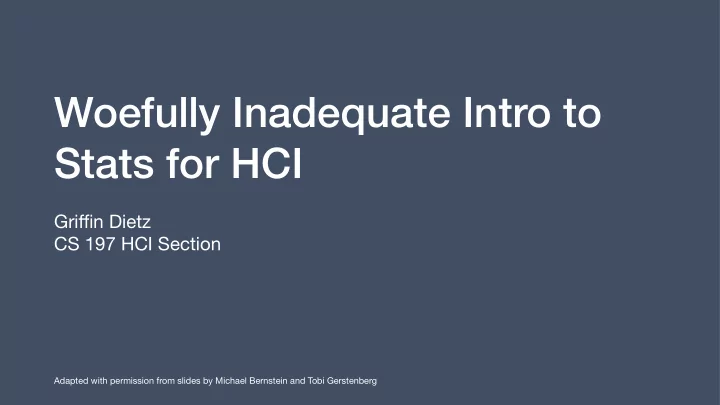

Woefully Inadequate Intro to Stats for HCI Gri ffi n Dietz CS 197 HCI Section Adapted with permission from slides by Michael Bernstein and Tobi Gerstenberg
But first…administrivia Feedback == more guidance needed —> “ambiguity challenge” and making the best use of office hours/section Link to materials in project reports Evaluation assignment early release
Null Hypothesis If your change/intervention had no effect what would the world look like? No slope in relationship No difference in means This is called the null hypothesis .
Null Hypothesis Significance Testing Given the data you collected/difference you observed, how likely is it to have occurred by chance? Probability of seeing a mean difference at least Probability of seeing a slope at this large, by chance least this large, by chance
Enter, p -values P-value is the probability of seeing the observed data by chance (or, the probability of a Type I error) Generally, p < .05 is accepted as “statistically significant” support for a condition difference
Types of Data Continuous (e.g., duration) Interval (e.g., exam scores) Ordinal (e.g., Likert scales) Binary (e.g., success/failure) Categorical (e.g., ethnicity) Type of data will change which statistical tests are appropriate.
A non-ideal method
A non-ideal method
Pearson’s Chi-Square For Comparing Two Population Counts (Binary Data)
Calculate Chi-Square “Five people completed the trial with the control interface, and twenty two completed it with the augmented interface.” control augmented 5 22 success failure 35 18
Calculate Chi-Square Determine the expected number of outcomes for each cell control augmented total success 5 22 27 failure 35 18 53 40 40 80 total Expected is (row total)*(column total) / overall total. Upper left: expected is 27*40/80 = 13.5
Calculate Chi-Square Expected values = (row total)*(column total) / overall total: control augmented total success 13.5 13.5 27 failure 26.5 26.5 53 40 40 80 total
Calculate Chi-Square Calculate a chi square statistics for each cell and sum over all cells χ 2 = ( observed − expected ) 2 expected control augmented 5.35 5.35 5.35 + 5.35 + success 2.73 + 2.73 = 2.73 2.73 16.16 failure 13
Calculate Degrees of Freedom � If we know there are a total of 40 participants… 5 ??? ??? 18 � We get (rows - 1) * (columns -1) degrees of freedom. So, if it’s a two-by-two design, one degree of freedom.
Result: Chi-Square Distribution 0.5 Very likely 0.4 Probability 0.3 χ 2 =16.16 χ 2 =1.8 0.2 0.1 Very unlikely 0.0 0 1 2 3 4 5 6 chi-square statistic with one degree of freedom
Pearson’s Chi-Square in R chisq.test (HCI R tutorial at http://yatani.jp/HCIstats/ChiSquare )
T-Test For Comparing Two Population Means (Continuous, Normally Distributed Data)
Normally Distributed Data σ std. dev. µ mean
T-test: Do two samples have the same mean? µ 2 µ 1 µ 2 µ 1 likely have different means likely have the same mean (null hypothesis)
Calculate the t-statistic Numbers that matter: µ 1 − µ 2 t = � Difference in means q N 1 + σ 2 σ 2 larger means more significant 1 2 � Variance in each group N 2 larger means less significant � Number of samples larger means more significant
Calculate Degrees of Freedom If we know the mean of N numbers, then only N-1 of those numbers can change. Example: pick three numbers with a mean of ten (e.g., 8, 10, 12). Once you’ve picked the first two, the third is set. We have two means, so a t-test has N-2 degrees of freedom.
Result: t-distribution Very likely 0.4 t = . 92 0.3 Probability 0.2 0.1 Very unlikely Very unlikely 0.0 -4 -2 0 2 4 t statistic with 18 degrees of freedom
T-test in R t.test (HCI R tutorial at http://yatani.jp/HCIstats/TTest )
Paired t-test for within-subjects design It can be easier to statistically detect a difference if the participants try both alternatives. Why? A paired test controls for individual-level differences. t = µ − 0 q σ 2 N Is the mean of that difference significantly different from zero?
Paired t-test in R Why no longer significant? (Hint: look at the degrees of freedom “df”) Ten participants. If we had twenty participants like before, much more likely.
ANOVA For Comparing N>2 Population Means (Continuous, Normally Distributed Data)
ANOVA: ANalysis Of VAriance Use instead of a t-test when you have > 2 factor levels/ conditions and a continuous DV Example: the effect of phone vs. tablet vs. laptop on number of searches successfully performed Very nice property: an ANOVA is just a regression with one predictor under the hood!
Linear Regression For Comparing N>2 Population Means (Continuous, Normally Distributed Data)
Linear Regression Data = Model + Error Y i = β 0 + β 1 X i + ϵ 0 Y i = β 0 + β 1 X i Model is a linear combination of predictors that minimizes error
Is there a relationship between chocolate and happiness?
Create a model with chocolate as a predictor
Is the model a better fit Or, does the model decrease error? 1 − SSE ( A ) SSE ( C ) = 1 − 2396.946 Proportional Reduction in Error (PRE) = 5215.016 ≈ 0.54 Model with chocolate as a predictor decreases error by about 54%.
Compute an F statistic 0.54/(2 − 1) PRE /( PA − PC ) F = (1 − PRE )/( n − PA ) = (1 − 0.54)/(10 − 2) = 9.4 PRE = Proportional reduction in error PA = number of parameters in Model C (PC) and Model A (PA) n = number of observations
Result: F-distribution 0.9 Very likely Probability 0.6 F = 9.4 0.3 Very unlikely 0.0 0 2.5 5 7.5 10 F statistic with eight degrees of freedom
Linear model in R t.test (HCI R tutorial at http://yatani.jp/HCIstats/TTest ) Impact of chocolate in model When chocolate goes up one, happiness goes up .56 (p = .015) Overall model fit
Recommend
More recommend